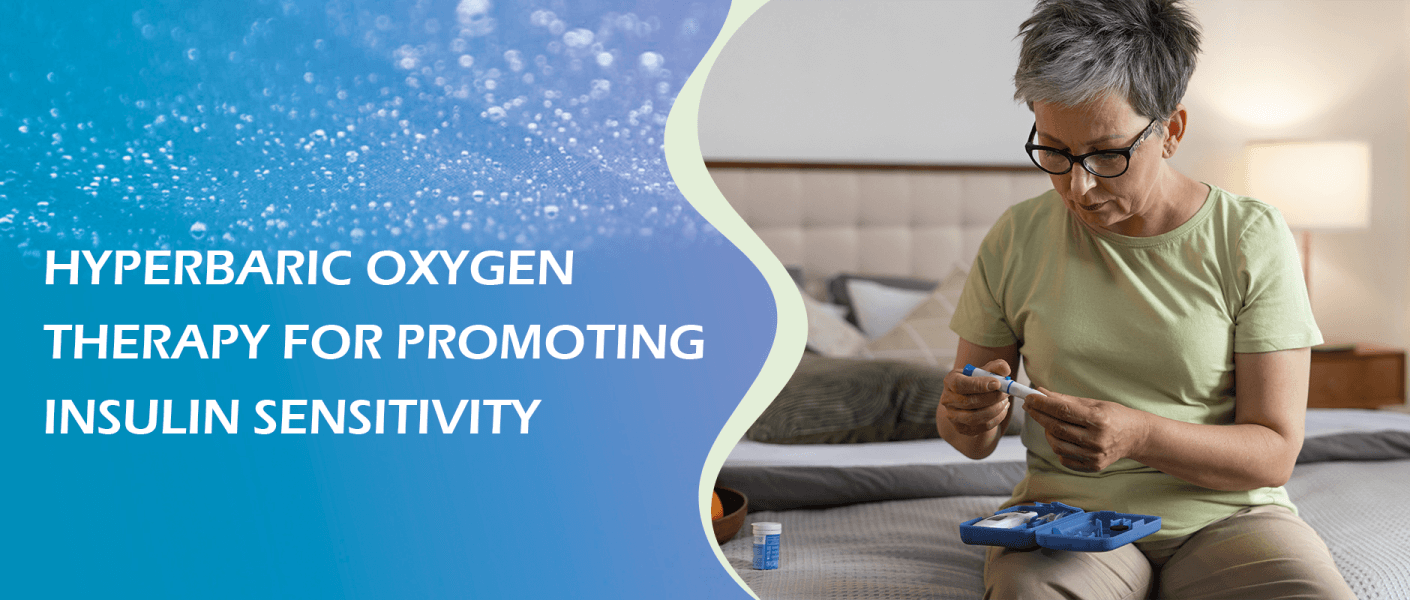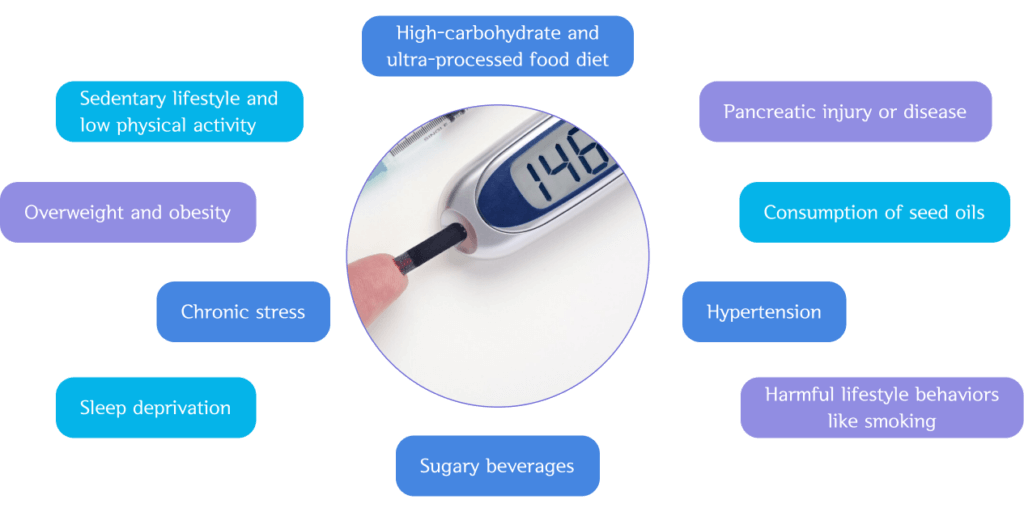
Diabetes mellitus (type 2 diabetes) is a serious metabolic condition that, if left unchecked, can dramatically undermine your health and reduce your quality of life. According to the Centers for Disease Control (CDC), nearly 15% of the US population over age 18 were confirmed to have type 2 diabetes in 2021, and another 38% had prediabetes. Diabetes and obesity go hand-in-glove, and given the trajectory of obesity in the United States, we can safely assume that type 2 diabetes continues to be on the rise.
An early sign of diabetes onset is insulin resistance, where glucose is unable to enter the body’s cells and continues to circulate in the bloodstream. Learn about the factors that contribute to insulin resistance and type 2 diabetes, solutions to reverse it, and how hyperbaric oxygen therapy (HBOT) can help improve insulin sensitivity in obese and diabetic populations.
Factors that Contribute to Type 2 Diabetes
Diabetes mellitus is a lifestyle-induced disease that has been on the rise over the past two decades. Once a condition that appeared mostly in old age, type 2 diabetes now affects young adults and even children. It is strongly associated with a cluster of metabolic disorders known as metabolic syndrome that includes obesity, hypertension, chronic systemic inflammation and heart disease.
Early indicators of pre-diabetes include elevated circulating blood sugar and increased insulin resistance in the cells. When you eat carbohydrate foods, they are broken down to glucose during digestion and released into the bloodstream. Insulin is a hormone that is produced in the pancreas and released in response to elevated blood glucose. Its job is to transport glucose from the bloodstream into the cells, to be used for energy metabolism.
Inside the cells, glucose is converted by the mitochondria into ATP, the energy molecule. When there is no immediate demand for ATP, glucose is stored in your muscle and liver cells in the form of glycogen, to be quickly recruited when energy demands increase, such as during exercise.
However, if you continue to eat carbohydrates but do not place energy demands on your cells, they reach their capacity for glucose storage, and they become insulin-resistant, preventing more glucose from entering. When that happens, glucose continues to circulate in your bloodstream, amplifying metabolic symptoms and affecting systems throughout your body.
Factors that contribute to the development of type 2 diabetes include:
- Overweight and obesity
- Sedentary lifestyle and low physical activity
- High-carbohydrate and ultra-processed food diet
- Sugary beverages
- Consumption of seed oils
- Sleep deprivation
- Chronic stress
- Harmful lifestyle behaviors like smoking
- Hypertension
- Pancreatic injury or disease

Solutions for Improving Insulin Sensitivity
The progression of type 2 diabetes can be halted and the condition can be reversed with the help of lifestyle modifications. Making just a few simple changes can make a substantial and immediate difference in your circulating glucose levels.
Adopt these lifestyle behaviors to accelerate weight loss with tirzepatide and maintain long-term results:
- Begin a simple walking program. Walking activates every joint in your body and recruits the large muscles in your lower extremities, increasing their energy demand. Exercise has an immediate effect on your glycogen stores, rapidly depleting them for energy production. As stores become depleted, insulin resistance is lowered to allow more glucose to enter the cell. Start with 15-30 minutes of walking per day, and gradually increase your pace and duration.
- Add resistance training 2-3 times per week. Glucose is the primary energy substrate for weight lifting exercises, and resistance training is one of the fastest ways to deplete glycogen stores and increase insulin sensitivity.
- Eliminate all sugary drinks from your diet, including fruit juices, and avoid artificial sweeteners. Switch to plain filtered water, or add a wedge of lemon for flavor.
- Eliminate ultra-processed foods and snack foods from your diet, and switch to a whole foods diet with plenty of vegetables and animal proteins.
- Try intermittent fasting (aka time-restricted feeding). By eating only within a limited time span of 6-12 hours, you can reduce your blood glucose levels and improve your insulin sensitivity. For example, on a 12-hour fast, if you eat your first meal at 8:00 am, you should stop all eating and drinking before 8:00 pm. One study found that intermittent fasting increases the rate of insulin-mediated glucose uptake, meaning that the cells become more insulin sensitive after a fasting interval.
- Cultivate good sleep habits by going to bed at the same time each night, sleeping in a cool, dark room, and avoiding screens right before bed. Turn off your cell phone, or move it away from your bedside. Sleep deprivation is a key driver of chronic systemic inflammation that leads to metabolic syndrome and diabetes.
In addition to lifestyle changes, you may benefit from glucagon-like peptide-1 (GLP-1) receptor agonist medications like semaglutide or tirzepatide. While these drugs can help improve your insulin sensitivity, they are meant to be supported by lifestyle modifications in diet and exercise.
Impact of HBOT on Insulin Sensitivity
The intensive infusion of oxygen into the cells during HBOT has a broad range of health benefits that affect multiple systems.
HBOT has been used for decades to treat serious medical conditions like burn and wound healing, decompression syndrome, carbon monoxide poisoning and other conditions. More recently, HBOT is being prescribed as a pre-and post-surgery intervention, to improve surgical outcomes and accelerate post-op healing.
Recent research has shown that hyperbaric oxygen therapy significantly increases insulin sensitivity in the peripheral cells of obese and diabetic patients. This is important, because diabetes affects peripheral circulation, fostering peripheral neuropathy and diabetic wounds. Regular HBOT sessions combined with recommended lifestyle changes can help improve your insulin sensitivity and reverse the symptoms of type 2 diabetes.
Leverage HBOT and Other Diabetes Solutions at Invita Wellness
The growing trend toward obesity and metabolic disorders has become a primary concern for health care providers, and it has even gotten the attention of politicians who identify poor health as a major threat to American wellbeing. Taking charge of your own health is more important now than ever if you want to live a full and productive life.
At Invita Wellness, we feature a broad range of products and services designed to improve your health, enhance your beauty, and supercharge your metabolism. Contact Invita Wellness today, and begin your journey to better health.
To begin your journey to better health
contact InVita Wellness today
Book Now
456 Broadway 2 Floor, New York, NY 10013, USA
Resources
Vasim, Izzah, Chaudry N. Majeed, and Mark D. DeBoer. “Intermittent fasting and metabolic health.” Nutrients 14.3 (2022): 631.
https://www.mdpi.com/2072-6643/14/3/631
Wilkinson, David, et al. “Hyperbaric oxygen therapy increases insulin sensitivity in overweight men with and without type 2 diabetes.” Diving Hyperb Med 45.1 (2015): 30-36.
http://www.dhmjournal.com/images/Journals/45/DHM_Vol45_No1.pdf#page=32